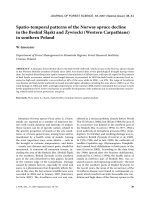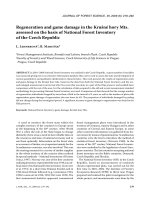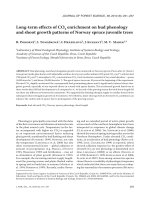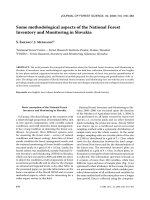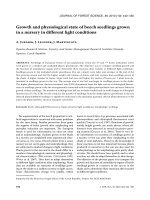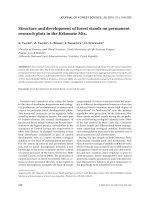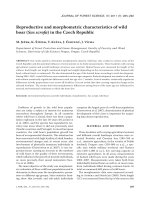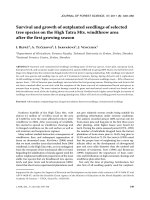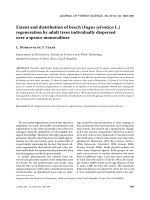Báo cáo lâm nghiệp: "partitioning and production of 15 N-labelled litter in beech trees" pps
Bạn đang xem bản rút gọn của tài liệu. Xem và tải ngay bản đầy đủ của tài liệu tại đây (508.15 KB, 9 trang )
Original
article
15
N
partitioning
and
production
of
15
N-labelled
litter
in
beech
trees
following
[
15
N]urea
spray
Bernd
Zeller
Micheline
Colin-Belgrand
a
Étienne
Dambrine
Francis
Martin
Écosystèmes
forestiers,
Centre
Inra
Nancy,
54280
Champenoux,
France
(Received
16
June
1997;
accepted
12
November
1997)
Abstract - The
leaves
of
10-year-old
beech
trees
grown
in
a
plantation
were
sprayed
once
in
late
summer
in
1993,
1994
and
1995
with
[
15
N]urea,
to
determine
the
15
N
utilization
by
beech
(Fagus
sylvatica
L.)
and
to
obtain
homogeneous
15
N-labelled
litter.
One
day
after
spraying,
leaves
had
incorporated
42
%
(1993)
to
55
%
(1995)
of
the
applied
[
15
N]urea.
The
leaf amino
acid
content
and
N
concentration
increased
shortly
after
application.
During
leaf
senescence,
approximately
88
%
of
the
incorporated
15
N
was
translocated
and
mainly
stored
in
the
above-ground
biomass.
After
spraying,
N
concentration
and
15
N
enrichment
of
leaves
were
measured
until
abscission.
In
spring,
trees
were
sampled
and
15
N
allocation
in
above-
and
below-ground
organs
were
determined
to
assess
15
N
partitioning.
Buds
and
bark
showed
the
highest
15
N
enrichment,
but
the
largest
amounts
of foliarly
applied
15
N
were
stored
in
bark
and
wood.
15
N
enrichment
of fallen
leaves
(i.e.
litter)
increased
after
each
15
N
urea
spray,
from
2.11
%
15
N
atom
excess
in
1993,
to
2.97
%
15
N
in
1994 and 3.14 %
15
N in
1995.
Annual
litter
contained
4.7%,
7.3
%
and
7.8 %
of
the
sprayed
15N.
Soluble
and
insoluble
N
fractions
showed
an
identical
15
N
atom
excess
indicating
a
homo-
geneous
distribution
of
15
N
in
the
labelled
leaves
as
well
as
litter.
(©
Inra/Elsevier,
Paris.)
15
N
/
urea
/
beech
litter
/
forest
/
nitrogen
Résumé -
Répartition
de
15
N
dans
le
hêtre
et
production
d’une
litière
marquée
après
pul-
vérisation
de
[
15
N]urée.
Afin
de
déterminer
l’utilisation
de
l’azote
par
le
hêtre
(Fagus sylvatica
L.)
et
pour
obtenir
une
litière
homogène
marquée
au
15N,
de
l’urée
enrichie
en
15
N
a
été
pulvé-
risée
en
fin
d’été
1993,
1994
et
1995
sur
le
feuillage
de jeunes
hêtres.
Après
la
pulvérisation,
les
concentrations
en
N
et
15
N
dans
les
feuilles
et la
litière
ont
été
mesurées
jusqu’à
l’abscission.
Un
jour
après
la
pulvérisation,
les
feuilles
ont
incorporé
entre
42
%
(1993)
et
55
%
(1995)
de
l’[
15
N]urée.
Une
brève
augmentation
de
la
teneur
en
acides
aminés
et
de
la
concentration
en
N
foliaire
a
eu
lieu
peu
après
l’application.
Au printemps
1994,
un
prélèvement
sur
cinq
arbres
a été
effectué,
pour
déterminer
la
répartition
de
15
N
dans
les
organes
aériens
et
souterrains
des
arbres.
Pendant
la
sénescence
des
feuilles,
88
%
de
l’azote
incorporé
est
transféré
dont
la
plus
grande
part
*
Correspondence
and
reprints
E-mail:
est
stockée
dans
les
organes
aériens
des
arbres.
Les
bourgeons
et
l’écorce
sont
les
tissus
les
plus
enrichis
en
15N,
mais
l’écorce
et
le
bois
accumulent
l’essentiel
de
l’azote
15N.
L’enrichissement
en
15
N
des
feuilles
sénescentes
(litière)
augmente
après
chaque
pulvérisation
d’[
15
N]urée ;
l’excès
isotopique
15
N
mesuré
en
1993
est
de
2,11
%
et
il
atteint
3,14
%
en
1995.
La
chute
annuelle
de
litière
représente
4,7, 7,3
et
7,8
%
de
15
N
pulvérisé.
Les
composés
azotées
solubles
et
insolubles
présentent
des
enrichissements
identiques
en
15N,
indiquant
une
distribution
homogène
de
15
N
dans
les
feuilles
et
également
dans
la litière.
(©
Inra/Elsevier,
Paris.)
15
N
/
urée
/
litière
/
hêtre
/
forêt
/
azote
1.
INTRODUCTION
Little
is
known
on
the
dynamics
of
leaching,
accumulation
and
release
of
N
in
decomposing
forest
litter
in
beech
ecosystems.
A
major
aim
of
the
current
investigations
was
to
study
the
mecha-
nisms
involved
in
the
uptake
and
release
of
N
from
litter.
The
determination
of
the
sizes
of
the
N
pools
involved
and
esti-
mates
of
their
turnover
in
litter
and
soil
had
been
efficiently
obtained
by
15
N
tracer
experiments
[1, 2].
Plant
residues
enriched
in
15
N
have
been
widely
used
as
tracers
in
N-cycling
experiments
in
agricultural
systems
[7,
11].
In
forest
ecosystems,
15N-
labelled
corn
straw
was
used
as
a
source
of
N and
C
in
studies
on N
mineralization
[2].
However,
replacing
of
straw
from
herbaceous
species
by
labelled
litter
from
the
species
under
investigation
(e.g.
beech)
would
make
it
possible
to
quantify
the
decomposition
and
mineralization
of
litter
with
few
modifications
to
the
litter
layer.
15
N-labelled
needle
litter
has
been
used
in
several studies
on
N
decomposition
and
mineralization
in
conifer
ecosystems
[1,
13].
This
approach
is,
however,
limited
by
the
production
of
large
amounts
of
15N-
labelled
litter
for the
species
under
inves-
tigation.
In
horticulture,
massive
labelling
of
trees
has
successfully
been
achieved
by
urea
spraying
[12,
14,
15].
Uptake
of
urea
N
by leaves
is
much
faster
than
for
NH
4+-
N and
NO
3-
-N
[3],
and
this
compound
is
rapidly
converted
into
amino
acids
[10]
and
later
to
proteins.
In
the
present
study,
a
field
experiment
was
conducted
to
determine
the
15
N
uti-
lization
by
beech
(Fagus
sylvatica
L.)
of
15
N
urea
sprayed
on
leaves
and
to
obtain
homogeneous
15
N-labelled
beech
litter.
The
major
aims
of
this
study
were
to
ascer-
tain
i)
that
N
originating
from
15
N
leaf
labelling
was
properly
distributed
into
beech
organs,
and
ii)
that
fallen
leaves
(i.e.
litter)
exhibited
homogeneous
15
N
labelling.
2.
MATERIALS
AND
METHODS
2.1.
15
N
labelling
A
field
experiment
was
conducted
on
a
calcareous
brown
earth
soil
(Calcisol)
in
a
large
natural
regeneration
area
at
Puvenelle
near
Pont-à-Mousson
(France).
The
10-
year-old
beech
trees
selected
for
the
15N-
labelling
experiment,
had
a
mean
height
of
1.25
m.
A
25-m
2
plot
containing
350
trees
was
carefully
cleaned
of understorey
veg-
etation
and
litter
from
previous
years.
Dur-
ing
late
summer,
tree
shoots
were
sprayed
in
the
evening
with
a
50-mM
aqueous
solution
of
[
15
N]urea
(99.5
%
15N)
(pH
6.2)
using
a
hand-sprayer.
The
urea
solu-
tion
(3.0
g
urea
L
-1
)
was
sprayed
as
a
fine
mist,
which
limited
the
formation
of
drops
and
consequently
the
contamination
of
the
soil
surface.
Nevertheless,
the
uptake
of
15
N
by
the
roots
could
not
be
excluded.
The
following
amounts
of
15
N
were
applied
per
tree:
56.6
mg
15
N
on
I
September
1993,
26.9
mg
15
N
on
22
August
1994
and
58.2
mg
15
N
on
30
August
1995.
In
1994
and
1995,
plots
were
covered
with
a
plastic
sheet
during
spraying
and
for the
following
36
h
to
avoid
volatilization
of
15N,
whereas
in
1993
they
were
not
covered.
The
highest
application
dose
on
1
ha
corresponded
to
8.0
kg
N.
2.2.
Sampling
Fifteen
leaves
from
the
upper,
inner
and
lower
crowns
were
randomly
taken
from
different
trees
at
regular
intervals
(weekly
and
fortnightly
in
1993;
monthly
in
spring
1994
and
1995)
and
before
and
after
the
application
of
[
15
N]urea.
From
mid
September
until
November,
senes-
cent
brown
leaves
(hereafter
referred
to
as
litter)
were
collected
weekly just
before
abscission.
In
February
1994,
five
trees
were
harvested
and
separated
into
the
fol-
lowing
compartments:
buds,
bark
(1993
=
year
of
growth),
wood
(1993),
bark
(1991-1992),
wood
(1991-1992),
bark
and
wood
(branches),
bark
(1991
and
ear-
lier),
wood
(1991
and
earlier),
roots
(<
1
mm),
roots
(>
1
mm),
roots
(>
3
mm).
Soil
samples
(n
=
5)
were
taken
at
a
depth
of
0-5
cm
and
5-20
cm
within
the
plot.
2.3.
Analyses
Sampled
leaves
were
rinsed
twice
with
distilled
water
and
weighed.
One
sub-
sample
was
dried
at
65 °C
until
constant
mass.
In
1993,
the
fresh
leaves
from
the
other
subsample
were
stored
at
-20 °C
and
used
later
to
determine
the
free
amino
acid
composition
after
extraction
in
methanol/water
(70/30,
v/v)
as
described
by
Genetet
et
al.
[4].
Fallen
leaves
(i.e.
leaf
litter)
collected
weekly
in
autumn
were
air-dried
and
stored
for
further
use
as
substrate
for
N
decomposition
studies
(Zeller
et
al.,
unpublished
results).
A
com-
posite
litter
sample
from
each
harvest
was
dried
at
65 °C.
All
tree
and
soil
samples
were
weighed
and
dried
at
65 °C.
After
dry-weight
deter-
mination,
all
samples
(tree
organs,
litter,
leaf,
soil)
were
milled
using
a
ball
mill
(Fritsch
Pulverisette
6)
to
pass
a
100-μm
mesh.
For
N
concentration
and
15
N
anal-
yses
of
litter,
tree
and
soil
samples,
about
6-10
mg
of
each
sample
were
weighed
in
silver
cups
and
carefully
closed.
Samples
were
then
combusted,
N
reduced
to
N2
and
the
14N/15
N
ratio
measured
on
a
Finnegan
MAT
Delta
S
mass
spectrome-
ter
at
the
Service
Central
d’Analyse
(CNRS,
Vernaison,
France).
The
incorporation
of
[
15
N]urea
into
beech
leaves
was
calculated
on
a
tree
basis
as
the
difference
between
sprayed
15
N
and
the
total
amount
of
new
15
N
in
all
leaves
1
day
after
spraying.
15
N
excess
=
atom
%
15
N
sample-0.3663
atom
%
15
N
3. RESULTS
3.1.
Amino
acid
composition
of
beech
leaves
During
late
summer,
the
most
abun-
dant
free
amino
acids
in
leaves
(lower
crown)
of
10-year-old
beech
trees
was
asparagine
(about
400
nmol
g
-1
fwt)
fol-
lowed
by
glutamate
and
glutamine
(fig-
ure
1).
After
application
of
[
15
N]urea,
asparagine
concentration
in
leaves
dra-
matically
decreased,
whereas
glutamine
and
glutamate
concentrations
drastically
increased
(figure
1).
Glutamate
concen-
tration
reached
a
peak
(600
nmol
g
-1
fwt)
I
day
after
spraying
and
then
rapidly
decreased
to
its
initial
concentration.
Glu-
tamine
concentration
increased
until
day
3
after
spraying
to
reach
400
nmol
g
-1
fwt
and
then
levelled
off.
Increased
glutamate
and
glutamine
concentrations
after
urea
application
indicate
a
rapid
assimilation
of
NH
4+
produced by
urea
catabolism.
3.2.
15
N
incorporation
in
leaves
15
N
concentration
in
leaves
sharply
increased
after
[
15
N]urea
application
and
then
rapidly
decreased
during
the
follow-
ing
weeks
(figure
2A)
suggesting
that
a
significant
part
of
the
applied
15
N
was
rapidly
translocated
to
other
tree
parts
and/or
lost
by
leaching.
One
day
after
spraying,
leaves
had
incorporated
42
%
(1993)
to
55
%
(1995)
of
the
applied
[
15
N]urea,
whereas
32.1
% of
the
applied
15
N
reached
the
soil
(1993).
The
differ-
ence
(27.4
%)
was
most
probably
due
to
volatilization
of
NH
3
(table
I).
After
the
first
[
15
N]urea
application
in
1993,
leaf
15
N
concentration
showed
a
high
differ-
ence
(figure
2A)
resulting
from
a
large
variability
in
15
N
incorporation
between
upper-
and
lower-crown
leaves
(0.37
and
1.01
mg
15
N
g
-1
dwt,
respectively).
15
N
enrichment
of
leaves
from
the
upper
crown
was
approximately
two
times
lower
than
in
leaves
of
the
inner
and
lower
crowns
(2.21
versus
6.12
excess
%
15
N).
Foliar
uptake
of
[
15
N]urea
increased
with
leaf biomass
as
suggested
by
the
increased
urea
incor-
poration
from
1993
to
1995
(table
1).
3.3.
15
N
partitioning
Leaf
senescence
began
in
mid
Septem-
ber
at
the
upper
crown
and
had
spread
to
the
whole
tree
crown
approximately
3
weeks
later.
During
leaf
senescence,
88
%
of
the
15
N
incorporated
in
leaves
was
allocated
to
perennial
tissues
of
beech
trees,
whereas
the
remaining
part
was
found
in
fallen
leaves.
15
N
distribution
in
the
different
perennial
parts
of
trees
har-
vested
in
February
1994
is
presented
in
figure
3.
15
N
from
urea
incorporated
by
leaves
was
allocated
to
the
various
organs
of
beech.
The
buds
formed
in
1993
showed
the
highest
15
N
concentration
of
all
plant
parts
(approximately
700
μg
15
N
g
-1
dwt).
Bark
and
wood
tissues
of
various
ages
showed
similar
15
N
concentrations,
whereas
roots
presented
slightly
lower
15
N
concentrations.
The
highest
amount
of
15
N
(25.2
%)
was
accumulated
in
wood
(<
1991),
the
largest
compartment
of
beech,
followed
by
wood
+
bark
of
branches
(16.6
%),
bark
(<
1991)
(14.0
%)
and
coarse
roots
(16.3
%).
In
May
1994,
the
15
N
stored
in
peren-
nial
tissues
was
remobilized
and
trans-
ported
to
the
growing
leaves,
where
the
15
N
concentration
reached
the
values
observed
after
urea
application
(figure
2A).
In
August,
the
15
N
content
of leaves
dras-
tically
decreased
indicating
an
active
inter-
nal
N
cycling
within
the
tree.
The
decrease
in
15
N
was
stronger
(-65
%)
than
the
decrease
in
total
leaf
N
(-40
%)
suggesting
that
a
large
part
of
15
N-labelled
com-
pounds
corresponded
to
easily
catabolized
metabolites,
such
as
amino
acids.
In
this
study,
5-8
%
of
the
applied
15
N
was
found
in
fallen
leaves,
i.e. litterfall
(table
I).
In
these
leaves,
the
15
N
enrich-
ment
of total
N
and
insoluble
N
(i.e.
pro-
tein
and
lignin
N)
was
identical
(2.06
and
2.11
excess
%
15
N).
Unlike
the
high
vari-
ability
of
15
N
enrichment
in
the
leaves,
the
15
N
enrichment
of litterfall
remained
nearly
constant
in
autumn
(1993).
In
1993,
leaf
litter
showed
a
mean
enrichment
of
2.11%
excess
15N.
In
autumn
1994
and
1995,
a
higher
enrichment
(2.97
and
3.14%
excess
15N,
respectively)
was
mea-
sured
in this
litter
as
a result
of
successive
[
15
N]urea
applications.
During
the
course
of
this
labelling
experiment,
4.9,
7.3
and
8.5
kg
of
15
N-labelled
beech
litter
were
produced
in
1993,
1994 and
1995, respec-
tively.
4.
DISCUSSION
Under
field
conditions,
urea
uptake
by
leaves
of
10-year-old
beech
trees
was
effi-
cient
and
a
large
and
increasing
propor-
tion
(42-55
%)
of
the
applied
[
15
N]urea
was
incorporated
into
plant
tissues.
This
increasing
incorporation
probably
resulted
from
the
increase
in
leaf biomass,
as
indi-
cated
by
the
amount
of
litter.
Even
higher
rates
of
incorporation
(60-80
%)
have
been
reported
for
apple
trees
[5, 6].
Several
reasons
can
be
suggested
to
explain
the
lower
urea
incorporation
in
sun
(upper)-
crown
leaves
after
the
first
spraying
in
1993.
Enhanced
urea
volatilization
from
upper
leaves
can
be
ruled
out
for the
fol-
lowing
years
because
the
plot
was
cov-
ered
with
a
plastic
sheet.
Higher
applica-
tion
of
urea
on
the
lower
crown
leaves,
was
observed
due
to
the
fall
of
urea
droplets
from
the
upper
crown
to
the
lower
crown.
This
is
suggested
by
the
soil
con-
tamination
as
measured
in
1993.
Lower
urea
incorporation
in
the
upper
crown
was
presumably
due
to
a
lower
metabolic
activity
of
these
leaves
senescing
earlier
than
the
leaves
of
lower
crowns.
The
dra-
matic
increase
of
free
glutamate
and
glu-
tamine
in
sprayed
leaves
(figure
1)
sug-
gests
that
the
catabolism
of
incorporated
urea
is
rapid
and
the
released
ammonium
N
is
assimilated
into
glutamate
and
glu-
tamine.
The
efficiency
of
the
foliar
uptake
of
sprayed
[
15
N]urea
by
beech
trees
grown
in
forest
plantations
depends
on
leaf
den-
sity.
Remobilization
of
leaf
N
in
senescent
leaves
allowed
an
efficient
translocation
of
incorporated
15
N
to
perennial
tissues
of
beech
trees.
About
88
%
of
incorporated
N
was
found
in
buds,
bark,
wood
and
roots.
The
buds
of
branches
exhibited
the
highest
15
N
excess,
but
most
(>80
%)
of
the
15
N
was
found
in
bark
and
wood
tis-
sues.
This
partitioning
is
in
agreement
with
that
found
in
other
deciduous
trees
[17].
In
other
tree
species,
retranslocated
N
is
stored
mostly
in
a
specific
family
of
gly-
coproteins,
called
vegetative
storage
pro-
teins, in
buds,
bark,
wood
and
roots
[8,
9,
17].
Despite
an
efficient
translocation
of
applied
15
N
to
perennial
tissues,
a
signif-
icant
proportion
of
15
N
was
measured
in
fallen
leaves
and
litter.
As
a result of
[
15N]
urea
application
during
late
summer,
N
translocation
to
other
plant
parts
was
lim-
ited
to
the
remobilization
processes
tak-
ing
place
during
leaf
senescence
with
little
dilution
and
transfer
of
15
N
by
import/export
mechanisms
characterizing
the
developing
leaves.
After
the
first
year
of
[
15
N]urea
application,
4.7
%
of
the
15
N
sprayed
was
found
in
litter
(table
I),
and
this
proportion
increased
to
7.3
%
in
1994
and
to
7.8
%
in
the
last
year
(1995)
of
urea
application.
In
1995,
the
excess
%
15
N
of
the
harvested
litter
reached
3.14
and
the
incorporated
15
N
was
homogeneously
dis-
tributed
in
the
soluble
and
insoluble
N
fractions.
In
summary,
spraying
[
15
N]urea
on
leaves
of
beech
trees
grown
in
the
forest
during
late
summer
readily
generates
large
amounts
of
15
N-labelled
litter.
Since
incor-
porated
15
N
is
homogeneously
distributed
between
the
different leaf
N
fractions,
the
harvested
litter
produced
could
potentially
be
used
to
investigate
uptake,
leaching
and
mineralisation
of
beech
litter
in
for-
est
ecosystems.
ACKNOWLEDGEMENTS
This
study
received
financial
support
from
the
EC
through
the
project
NiPhys
(ENV4.CT.950053).
The
ONF
(Office
National
de
la
Forêt,
France)
and
Mr
Claude
Robert
are
gratefully
acknowledged
for the
possibility
to
work
in
the
forest
of
Puvenelle.
We
would
like
to
thank
all
colleagues
of
the
’Équipe
Cycles
Biogéochimiques’
for
help
in
the
field
or
in
the
laboratory.
REFERENCES
[1]
Berg
B.,
Dynamics
of nitrogen
(
15N)
in
decomposing
Scots
pine
(Pinus
sylvestris)
needle
litter.
Long-term
decomposition
in
a
Scots
pine
forest,
VI,
Can.
J.
Bot.
66
(1988)
1539-1546.
[2]
Bottner
P.,
Austrui
F.,
Cortez
J.,
Billes
G
Couteaux
M.M.,
Decomposition
of
14
C
and
15
N
labelled
plant
material,
under
controlled
conditions, in
coniferous
forest
soils from
a
North-South
climatic
sequence
in
Western
Europe,
Soil.
Biol.
Biochem.
(1997)
(in
press).
[3]
Coker A., Court
D.,
Sylvester
W.B.,
Evalua-
tion
of
foliar
urea
applications
in
the
pres-
ence
and
absence
of surfactant
on
the
nitrogen
requirements
of
conditioned
Pinus
radiata
seedlings,
New
Zealand
J.
For.
Sci.
17
(1987)
51-66.
[4]
Genctet
I.,
Martin
F.,
Stewart
G.,
Nitrogen
assimilation
in
mycorrhizas.
Ammonium
assimilation
in
the
N-starved
ectomycorrhizal
fungus
Cenococcum
graniforme.
Plant.
Phys-
iol.
76
(1984) 395-399.
[5]
Han
Z.,
Zeng
X.,
Wang
F.,
Effects
of autumn
foliar
application
of
15
N-urea
on
nitrogen
storage
and
reuse
in
apple,
J.
Plant.
Nutr. 12
(1989) 675-685.
[6]
Hill-Cottingham
D.G.,
Lloyd-Jones
C.P.,
Nitrogen-15
in
apple
nutrition
investigations,
J. Sci.
Food
Agric.
26
(1974)
165-173.
[7]
Jordan
D.,
Rice
C.W.,
Ticdje
J.M.,
The
effect
of
suppression
treatments
on
the
uptake
of
15
N
by
intercropped
com
from
labelled
alfalfa
(Medicago
sativa),
Biol.
Fert.
Soils
66
(1993)
221-226.
[8]
Kang
S.M.,
Titus
J.S.,
Qualitative
and
quan-
titative
changes
in
nitrogenous
compounds
in
senescing
leaf and
bark
tissues
of
the
apple,
Physiol.
Plant.
50
(1980)
285-290.
[9]
Kato
T.,
Nitrogen
metabolism and
utilisation
in
Citrus,
Hortic.
Rev.
8
(1986)
181-216.
[10]
Karasuyama
M.,
Yeneyama
T.,
Kobayashi
H.,
15
N
study
on
the
fate
of
foliarly
applied
urea
nitrogen
in
tea
plant,
Soil
Sci.
Plant Nutr.
31 (1985) 123-131.
[11]
Norman
R.J.,
Gilmour
J.T.,
Wells
B.R.,
Min-
eralization
of
nitrogen
from
nitrogen-15
labeled
crop
residues
and
utilization
by
rice,
Soil
Sci.
Soc.
Am.
J.
54
(1990)
1351-1356.
[12]
Oland
K.,
Nitrogen
feeding
of apple
trees
by
post
harvest
urea
sprays,
Nature
185
(1960)
857.
[13]
Preston
C.M.,
Mead
D.J.,
Long-term
recovery
in
the
soil
profile
of
15
N
from
Douglas-fir
needles
decomposing
in
the
forest
floor,
Can.
J. For. Res.
25
(1995) 833-837.
[14]
Shim
K.K.,
Titus
J.S.,
Splittstoesser
W.E.
The
utilization
of
post-harvest
urea
sprays
by
senescing
apple
leaves,
J.
Am.
Soc.
Hortic.
Sci.
97
(1972)
592-596.
[15]
Shim
K.K.,
Titus
J.S.,
Splittstoesser
W.E.,
The
fate
of
carbon
and
nitrogen
from
urea
applied
to
foliage
of senescing
apple
trees,
J.
Am.
Soc.
Hortic.
Sci.
98
(1973)
360-366.
[16]
Stepien
V.,
Contribution
à l’étude
des
pro-
téines
de
reserve
végétatives
du
Peuplier
(Populus
x
euramericana),
Université
de
Nancy I, France.
[17]
Stepien
V., Sauter J.J.,
Martin
F.,
Vegetative
storage
proteins
in
woody
plants,
Plant
Phys-
iol.
Bioch.
32
(1994)
185-192.

